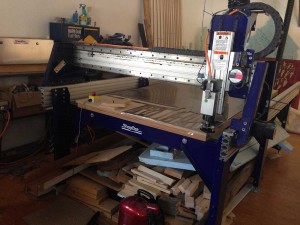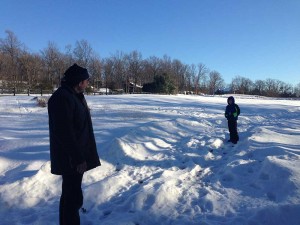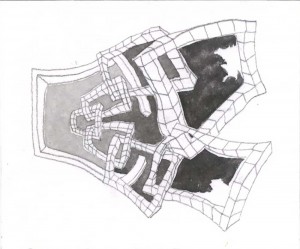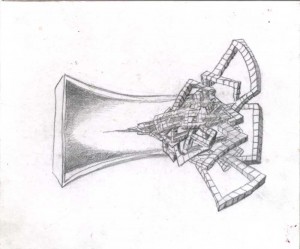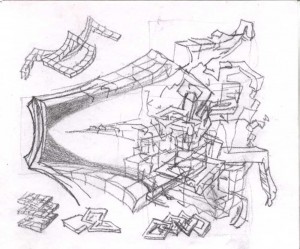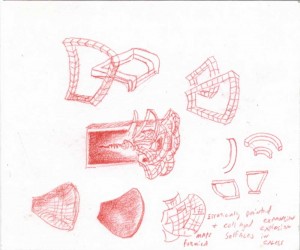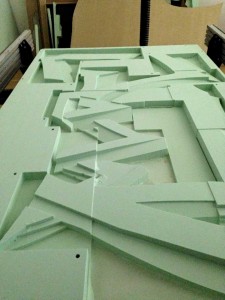John F. Simon, Jr.: Creative Process
- Oct 5, 2014
- 6 min read
Updated: Jul 10, 2020
A studio visit with Juliette Yuan, curator
Film by David Bates, Jr./Streaming Museum
John F. Simon, Jr.’s Moment of Expansion, 2014, is part of “The Artist’s Creative Process” series, produced by curator Xiaoying Juliette Yuan, that explores the practice of internationally known artists who reveal their creative process step by step and the relationship between their lives and their art. Other artists in the series include Stephanie Rothenberg and LoVid.
OVERVIEW
Moment of Expansion, 2014 HDU, Trupan, acrylic paint & plastic laminate 108 x 192 x 3 inches
John explains why he considers Moment of Expansion to be his second masterpiece:
“My feeling is that an artist’s state of mind when making a work is critical to what the work transmits to the viewer. I have always worked to improve on methods, technique, and materials, but only recently have I found that I can also improve the inner workings; I can develop the mental aspects of my art practice.
I look back at my piece called “ComplexCity” (2000) and I see how open and relaxed I was during its creation. When an athlete is in the ‘zone’ the fans sometimes say, “he was unconscious” meaning he played flawlessly and as if by instinct. I think ComplexCity was this kind of peak zone for me, a masterpiece of unconscious transmission. So many decisions in that software worked way beyond my expectations. The downfall is that once I saw it working, I was conscious of what was possible, and it became harder to achieve the flow – self-consciousness took over – and it has taken many years for me to own that and regain control of the process..
Fourteen years after the first steps of this journey, I feel like I am creating as freely as when I made ComplexCity but the difference is that having built my concentration with mindfulness training, I am present during the decision making.
Now I practice working intuitively but with awareness. I am excited to share ”Moment of Expansion” because it is the first work since ComplexCity where every decision has arisen naturally from inspiration, joy, and intuition – and the growth for me, after working for so long, is that I can be present to watch it happen. I am most happy about the charcoal lines because I successfully incorporated a hand gesture into so much mechanical production. I was terribly nervous when I put them on the piece – and because I draw every day it also seemed ridiculous to me to be so nervous – but I just kept repeating to myself, ‘This line, just like every other line. This line, just like every other line’ And it all worked out. “
1-STUDIO


In 2008 Simon left Manhattan (after living in the city 21 years) and took up residence about 50 miles to the northwest in Orange County, NY. There he converted an empty 1200 sqft pole barn into his art studio. WIth the extra space he was able to install a CNC router that could handle 4′ X 8′ sheet material and immediately started working at a larger scale.
In the studio you will also find a Universal Laser that he uses for cutting formica and plexiglass. Simon works in a kind of creative chaos, surrounded by experiments and interesting scraps that are the negative spaces of what he cuts. His work is centered around his computer for 3D modeling and several tables for drawings. There is ample wall space to hang the larger works.



2-SKETCHES
The mainstay of Simon’s practice is his daily improvisational drawing. He sits and allows his hand to move freely; reacting to whatever arises. Over long periods of time, some motifs become persistent in the work. “I look for what emerges,” states Simon, “And what won’t go away, I begin to refine and enlarge, to see in space and with texture. This is how my larger works are developed, I let the process speak.”


3-ADOBE ILLUSTRATOR
Once a sketch is chosen, Simon scans it and begins to create outlines using the bezier pen tool. He creates an interlocking set of 2D shapes, thinking about the planar design and internal composition. At this stage, Simon also experiments with scale and proportion, sometimes modifying the sketch, and also dividing the work into pieces for production.





4-RHINOCEROS FOR MACINTOSH
The 2D vector outlines are imported into Rhino. Each outline is extruded into a 3D shape. Here Simon can play with the way the pieces interlock, make subtle bends and folds, and create the visual textural feel of the surface.


5-FINISHING
To take the piece from computer model to physical materials, Simon has a ShopBot CNC router. His material of choice is a 2″ thick wood like substance called HDU. He uses a 1/8″ ball nose end mill for the final passes. The machine moves the carving bit across the surface like a raster printer, raising and lowering it along the path to create smooth sloping surfaces. The ShopBot is also used to cut plastic and metal laminates that are adhered to the surface, giving smooth and shiny textures to contrast with areas of paint.






6-FINAL PIECE
The final work is 16 feet wide and 9 feet tall; made across four sheets of HDU. Simon’s finishing touch is to draw freehand using charcoal pencils. He explains, “This is the union of opposites; the hard industrial edges of the laminate next to the soft and looping charcoal lines, reminding us that there are people inside the machine.”






JOHN F. SIMON, JR.
John F. Simon, Jr. is one of the pioneers in the development of Software Art and is renowned in this area for articulating the use of code in digital and multimedia works since the mid 1980s. This early community of artists and curators created the first wave of software applications, web-based projects and digital approaches to art making, which continue to expand in new directions every year. As an example, in 2011 Simon completed an app for Icelandic singer Björk’s new album, Biophilia; the first app album ever created
Simon makes drawings every day. His “Divination Drawings“ are a years-long practice of daily hand drawings which the artist uses to meditate, but also as source material for larger works. Drawings from the Divination series begin intuitively; a pencil drawing or watercolor is started and then guided by the unconscious thoughts and emotions of that day. Simon’s interests include the scientific, spiritual and natural worlds, with mathematics usually playing the connecting role. Where many people see technical proficiency, others see art historical references, the beauty of scientific minutia, and the delicate nuances that occur from years of color studies. The drawings shared daily through the artist’s website www.iclock.com, are the source of his symbolism and his engine for artistic growth. When an image persists in these drawings, Simon translates it into something larger and more dimensional. He works in diverse media such as: software, computers, paint, pencil, wood, HDU, formica, and linoleum and frequently uses computer controlled fabrication tools like a laser cutter and CNC router.
His seminal work “Every Icon” was included in the Whitney Biennial (2000). Simon’s artworks can be found in the permanent collections of The Whitney Museum of American Art, The Solomon R. Guggenheim Museum, The Museum of Modern Art in New York, Collezione Maramotti, The Brooklyn Museum, The Los Angeles County Museum of Art and The San Francisco Museum of Modern Art, among others. In October 2005 the Whitney Museum of American Art and Printed Matter published Simon’s artist’s book and software CD, “Mobility Agents” based on the notebooks of Paul Klee.
He holds an MFA degree from the School of Visual Arts in Manhattan and a Masters degree in Earth and Planetary Sciences from Washington University in St. Louis. He is represented in New York by Sandra Gering, Inc.
NUMERAL.COM
ICLOCK.COM
CURATOR, JULIETTE YUAN

Xiaoying Juliette Yuan is a curator based in New York. She has curated numerous exhibitions, conferences, and workshops for international biennials and festivals and worked with international art fairs, academies, and institutions. As a trilingual scholar, she has widely published in art magazines and journals and lectured at conferences and academies. In 2012, she was appointed the curator for Syncretic Cybernetics, the first retrospective of Roy Ascott, the British pioneer in the telematic art within the 9th Shanghai Biennale in China. In 2013, she accomplished a large publication project, “Media Arts Collection” introducing a group of Western media art pioneers’ writings to China. In 2013, she curated for Havestwork’s New York Electronic Festival (NYEAF) a screening program presenting a series of sound works from a group of emerging artists from China Mainland. In 2015, she collaborated with Harvestworks and the NYEAF again to showcase in New York the sound projects of five pioneer artists from Taiwan and Hong Kong. The project received significant support from the Ministry of Culture in Taipei, TECO Taipei Cultural Center (New York), and the Museum of the Moving Image (New York). As a researcher focusing on curatorial aesthetic and methodology, she is interested in artists’ creative processes as well as the curators’ role in such processes.





